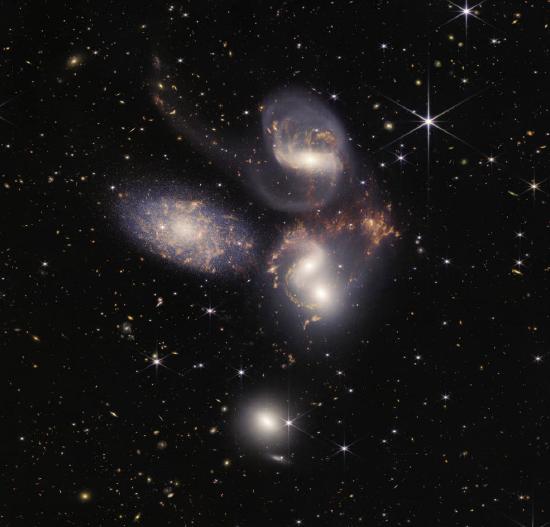1.1: The Scientific Method and Physics
- Page ID
- 68421
- Describe the scope of physics.
- Calculate the order of magnitude of a quantity.
- Compare measurable length, mass, and timescales quantitatively.
- Describe the relationships among models, theories, and laws.
Like all sciences, physics is devoted to the understanding natural phenomena. In particular, in physics, we try to understand all physical phenomena from the world of the very small invisible subatomic particles to stars, galaxies and the entire universe. Scientific findings whether they are just verified observations, laws or theories are just attempts to describe nature. Anyone can and should challenge and improve these findings by performing experiments and collecting evidence.
The Scope of Physics

Take a look at the image of Stephan's Quintet in Figure \(\PageIndex{1}\). Each of the Galaxies contains billions of individual stars as well as huge clouds of gas and dust. This pair of galaxies lies a staggering 290 million light-years away (\(\approx\)1.7 x 1021 mi) from our own Milky Way galaxy. The stars and planets that make up each of these galaxies might seem to be the furthest thing from most people’s everyday lives, but the forces that cause the Galaxies to act as they do are thought to be the same forces we contend with here on Earth. The gravity that causes the stars of a Galaxy to rotate and revolve is thought to be the same as what causes water to flow over hydroelectric dams here on Earth. Through a study of physics, you gain a greater understanding of the interconnectedness of everything we can see and know in this universe.
Think, now, about all the technological devices you use on a regular basis. Computers, smartphones, global positioning systems (GPSs), MP3 players, and satellite radio might come to mind. Then, think about the most exciting modern technologies you have heard about in the news, such as trains that levitate above tracks, “invisibility cloaks” that bend light around them, and microscopic robots that fight cancer cells in our bodies. All these groundbreaking advances, commonplace or unbelievable, rely on the principles of physics. Aside from playing a significant role in technology, professionals such as engineers, pilots, physicians, physical therapists, electricians, and computer programmers apply physics concepts in their daily work. For example, a pilot must understand how wind forces affect a flight path; a physical therapist must understand how the muscles in the body experience forces as they move and bend. As you will learn in this text, the principles of physics are propelling new, exciting technologies, and these principles are applied in a wide range of careers.
The underlying order of nature makes science in general, and physics in particular, interesting and enjoyable to study. For example, what do a bag of chips and a car battery have in common? Both contain energy that can be converted to other forms. The law of conservation of energy (which says that energy can change form but is never lost) ties together such topics as food calories, batteries, heat, light, and watch springs. Understanding this law makes it easier to learn about the various forms energy takes and how they relate to one another. Apparently unrelated topics are connected through broadly applicable physical laws, permitting an understanding beyond just the memorization of lists of facts.
Science consists of theories and laws that are the general truths of nature, as well as the body of knowledge they encompass. Scientists are continuously trying to expand this body of knowledge and to perfect the expression of the laws that describe it. Physics, which comes from the Greek phúsis, meaning “nature,” is concerned with describing the interactions of energy, matter, space, and time to uncover the fundamental mechanisms that underlie every phenomenon. This concern for describing the basic phenomena in nature essentially defines the scope of physics.
Physics aims to understand the world around us at the most basic level. It emphasizes the use of a small number of quantitative laws to do this, which can be useful to other fields pushing the performance boundaries of existing technologies. Consider a smartphone (Figure \(\PageIndex{1}\)). Physics describes how electricity interacts with the various circuits inside the device. This knowledge helps engineers select the appropriate materials and circuit layout when building a smartphone. Knowledge of the physics underlying these devices is required to shrink their size or increase their processing speed. Or, think about a GPS. Physics describes the relationship between the speed of an object, the distance over which it travels, and the time it takes to travel that distance. When you use a GPS in a vehicle, it relies on physics equations to determine the travel time from one location to another.
Knowledge of physics is useful in everyday situations as well as in nonscientific professions. It can help you understand how microwave ovens work, why metals should not be put into them, and why they might affect pacemakers. Physics allows you to understand the hazards of radiation and to evaluate these hazards rationally and more easily. Physics also explains the reason why a black car radiator helps remove heat in a car engine, and it explains why a white roof helps keep the inside of a house cool. Similarly, the operation of a car’s ignition system as well as the transmission of electrical signals throughout our body’s nervous system are much easier to understand when you think about them in terms of basic physics.
Physics is a key element of many important disciplines and contributes directly to others. Chemistry, for example—since it deals with the interactions of atoms and molecules—has close ties to atomic and molecular physics. Most branches of engineering are concerned with designing new technologies, processes, or structures within the constraints set by the laws of physics. In architecture, physics is at the heart of structural stability and is involved in the acoustics, heating, lighting, and cooling of buildings. Parts of geology rely heavily on physics, such as radioactive dating of rocks, earthquake analysis, and heat transfer within Earth. Some disciplines, such as biophysics and geophysics, are hybrids of physics and other disciplines.
Physics has many applications in the biological sciences. On the microscopic level, it helps describe the properties of cells and their environments. On the macroscopic level, it explains the heat, work, and power associated with the human body and its various organ systems. Physics is involved in medical diagnostics, such as radiographs, magnetic resonance imaging, and ultrasonic blood flow measurements. Medical therapy sometimes involves physics directly; for example, cancer radiotherapy uses ionizing radiation. Physics also explains sensory phenomena, such as how musical instruments make sound, how the eye detects color, and how lasers transmit information.
It is not necessary to study all applications of physics formally. What is most useful is knowing the basic laws of physics and developing skills in the analytical methods for applying them. The study of physics also can improve your problem-solving skills. Furthermore, physics retains the most basic aspects of science, so it is used by all the sciences, and the study of physics makes other sciences easier to understand.
To accomplish your goals in any of the various fields within the natural sciences and engineering, a thorough grounding in the laws of physics is necessary. The reason for this is simply that the laws of physics govern everything in the observable universe at all measurable scales of length, mass, and time. Now, that is easy enough to say, but to come to grips with what it really means, we need to get a little bit quantitative.
Laws, Models and Theories
In science discussions, you will encounter terms like hypothesis, law, model and theory. These are tools that humans have developed in our quest to understand nature. Laws and theories are human statements of the underlying laws or rules that all natural processes follow. Laws and theories are intrinsic to the universe; humans did not create them and cannot change them. We can only discover and understand them. Their discovery is a very human endeavor, with all the elements of mystery, imagination, struggle, triumph, and disappointment inherent in any creative effort. The cornerstone of discovering natural laws or theories is observation and data; scientists must describe the universe as it is, not as we imagine it to be.
A hypothesis is an educated guess about an observation, finding, or data that that can be tested. It can be a proposed answer to a scientific question, a prediction about the outcome of an experiment or an explanation for a natural phenomenon.
A law uses concise language to describe a generalized pattern in nature supported by scientific evidence and repeated experiments. Often, a law can be expressed in the form of a single mathematical equation. Laws and theories are similar in that they are both scientific statements that result from a tested hypothesis and are supported by scientific evidence. However, the designation law is usually reserved for a concise and very general statement that describes phenomena in nature, such as the law that energy is conserved during any process, or Newton’s second law of motion, which relates force (F), mass (m), and acceleration (a) by the simple equation \(\sum \vec{F} = m \vec{a}\) F = ma. More limited statements are usually called principles (such as Pascal’s principle, which is applicable only in fluids), but the distinction between laws and principles often is not made carefully.
The word theory means something different to scientists than what is often meant when the word is used in everyday conversation. In particular, to a scientist a theory is not the same as a “guess” or an “idea” or even a “hypothesis.” The phrase “it’s just a theory” seems meaningless and silly to scientists because science is founded on the notion of theories. To a scientist, a theory is a testable explanation for patterns in nature supported by scientific evidence and verified multiple times by various groups of researchers. Some theories include models to help visualize phenomena whereas others do not. Newton’s theory of gravity, for example, does not require a model or mental image, because we can observe the objects directly with our own senses. The kinetic theory of gases, on the other hand, is a model in which a gas is viewed as being composed of atoms and molecules. Atoms and molecules are too small to be observed directly with our senses—thus, we picture them mentally to understand what the instruments tell us about the behavior of gases. A theory should describe all aspects of any system that falls within its domain of applicability. In particular, any experimentally testable implication of a theory should be verified. If an experiment ever shows an implication of a theory to be false, then the theory is either thrown out or modified suitably (for example, by limiting its domain of applicability). The biggest difference between a law and a theory is that a theory is much more complex and dynamic. A law describes a single action whereas a theory explains an entire group of related phenomena.
A model is a representation of something that is often too difficult (or impossible) to display directly. Although a model is justified by experimental tests, it is only accurate in describing certain aspects of a physical system. An example is the Bohr model of single-electron atoms, in which the electron is pictured as orbiting the nucleus, analogous to the way planets orbit the Sun (Figure \(\PageIndex{4}\)). We cannot observe electron orbits directly, but the mental image helps explain some of the observations we can make, such as the emission of light from hot gases (atomic spectra). However, other observations show that the picture in the Bohr model is not really what atoms look like. The model is “wrong,” but is still useful for some purposes. Physicists use models for a variety of purposes. For example, models can help physicists analyze a scenario and perform a calculation or models can be used to represent a situation in the form of a computer simulation. Ultimately, however, the results of these calculations and simulations need to be double-checked by other means—namely, observation and experimentation. Moreover, due to various types of limitations or requirements, we often use simple models to help describe intricate phenomena. For example, when investigating the trajectory of a basket ball, for most practical purposes, it is sufficient to use a model that ignores the effects of air resistance.
The models, theories, and laws we devise sometimes imply the existence of objects or phenomena that are as yet unobserved. These predictions are remarkable triumphs and tributes to the power of science. It is the underlying order in the universe that enables scientists to make such spectacular predictions. However, if experimentation does not verify our predictions, then the theory or law is wrong, no matter how elegant or convenient it is. Laws can never be known with absolute certainty because it is impossible to perform every imaginable experiment to confirm a law for every possible scenario. Physicists operate under the assumption that all scientific laws and theories are valid until a counterexample is observed. If a good-quality, verifiable experiment contradicts a well-established law or theory, then the law or theory must be modified or overthrown completely. The study of science in general, and physics in particular, is an adventure much like the exploration of an uncharted ocean. Discoveries are made; models, theories, and laws are formulated; and the beauty of the physical universe is made more sublime for the insights gained.
Read the following statement then determine whether or not it is scientific.
Heaven is Hotter than Hell!
Published in Applied Optics II, A14 (1972) & Random Walk in Science
The temperature of Heaven can be rather accurately computed from available data. Our authority is the Bible: Isaiah 30:26 reads, Moreover the light of the Moon shall be as the light of the Sun and the light of the Sun shall be sevenfold, as the light of seven days. Thus Heaven receives from the Moon as much radiation as we do from the Sun and in addition seven times seven (forty-nine) times as much as the Earth does from the Sun, or fifty times in all. The light we receive from the Moon is a ten-thousandth of the light we receive from the Sun, so we can ignore that. With these data we can compute the temperature of Heaven. The radiation falling on Heaven will heat it to the point where the heat lost by radiation is just equal to the heat received by radiation. In other words, Heaven loses fifty times as much heat as the Earth by radiation. Using the Stefan-Boltzmann fourth-power law for radiation
\((𝐻/𝐸)^4=50\)
where E is the absolute temperature of the Earth-300K. This gives H as 798 K (525º C).
The exact temperature of Hell cannot be computed but it must be less than 444.6º C, the temperature at which brimstone or sulfur changes from a liquid to a gas. Revelations 21: 8: But the fearful, and unbelieving... shall have their part in the lake which burneth with fire and brimstone. A lake of molten brimstone means that its temperature must be below the boiling point, which is 444.60C. (Above this point it would be a vapor, not a lake.)
We have, then, temperature of Heaven, 525º C. Temperature of Hell, less than 445º C. Therefore, Heaven is hotter than Hell.
- Solution
-
Think of the sources and data discussed in the article. Is any of them available for anyone, at anytime to verify?
Answer: No, it is not scientific since it does nto rely on data that can easily be verified.
Major Characteristics of scientific knowledge
Science is what humanity has developed and continue to develop in its quest to understand nature. Here are some of the characteristics of science:
Verifiable – Based on data
Objective – avoid biases, prejudices, wishes, and beliefs
Reproducible/Reliable – the same results/findings can be reproduced.
Precise and Accurate – as apposed to social sciences which are not as easily quantifiable leading to less precise results
Universally Replicable
Universally observable
Malleable – evolves and changes based on new evidence
How Science Evolves
What was once believed to be true in science can be adjusted or rejected based on new evidence.
New findings cannot be rejected because it does not conform to current knowledge
A new finding is deemed valid only after thorough assessment.
Additional studies are needed following new to provide for a broad assessment of where the weight of evidence falls.
Over time, as additional data is gathered and verified,
Theories don't become laws and laws don't become theories
The following two images were posted in the media during the Covid epidemic. They are accusing Dr. Anthony Fauci of flip-flopping when discussing preventive measures to avoid Covid.


- Solution
-
The red line goes through the points C and F, so the line is \(\overleftrightarrow{CF}\).
Answer: \(\overleftrightarrow{CF}\)
Science is a Collective Human Endeavor
Science evolves - new technologies allow for new data that can confirm or dispute prior knowledge. New knowledge also allows us to revisit some of our current understanding.
Scientific knowledge is a collective human endeavor. Individual scientist contributions cannot happen (would have not happened) without the contribution of contemporary and prior scientists. In other words, Newton's findings or Einstein's findings would have been found even if Einstein and Newton did not exist. While both were exceptional scientists, the evolution of scientific knowledge would have happened with or without them.
Science is based on data and only data. Both laws and theories are supported by extensive reproducible data. If you cannot test it, it is not science.


